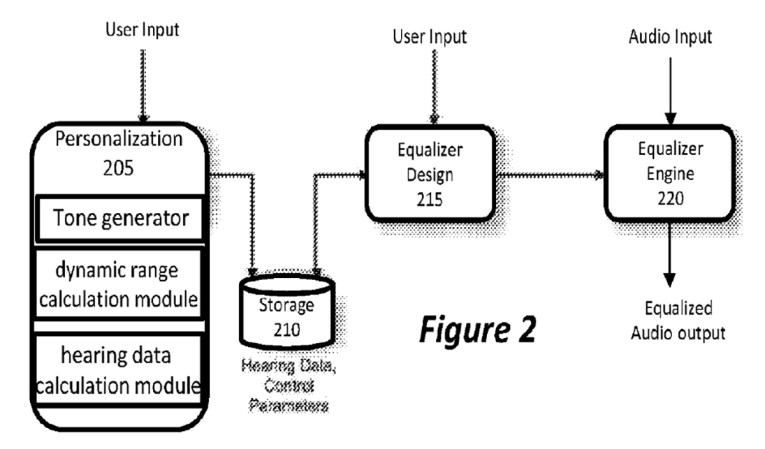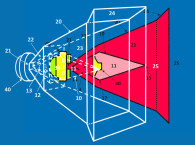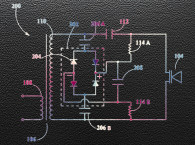
System and Method for Improved Audio Perception
Patent Application Publication Number: 2016/0277855
Inventors: Yair Raz; (Aventura, FL)
Assignee: Innovo IP, LLC (Aventura, FL)
Filed: December 22, 2015
Current CPC Class: H04R 25/50
Published: September 22, 2016
Number of Claims: 21
Number of Drawings: 13
Abstract from Patent
This invention describes methods of Audio Signal Personalized Enhancement for optimal listening to music. A combination of hearing test, audio signal compensation, and signal processing algorithms are implemented jointly in an audio Device. An audio signal is processed and tuned within the entire range of audible frequencies to actively compensate for both the characteristics of the listening device, and the specific hearing characteristics of the listener, resulting in a much improved music listening experience. A randomized self-test algorithm is used to analyze user’s hearing ability in each ear within a preselected dynamic volume range at multiple frequencies spanning the audible spectrum.
Independent Claims
1. A computer-implemented method for adjusting equalization of audio player individualized for a user, comprising: performing a dynamic range calculation to determine the dynamic hearing range of the user for a plurality of predetermined frequencies; performing a hearing data calculation to determine an upper and a lower level for each of the plurality of predetermined frequencies for each ear of the user individually; using the output of the hearing data calculations to adjust an equalization of an audio player to obtain a user tailored equalization; applying the user tailored equalization to an audio signal prior to playing the audio file to the user.
12. A method for adjusting equalization of audio player individualized for a user, comprising: generating a series of a plurality of tones of different frequencies; performing the following operations at least once: sounding the series in one ear of the user and requesting an input from the user indicating whether all of the plurality of the tones were heard; and, playing the series in second ear of the user and requesting an input from the user indicating whether all of the plurality of the tones were heard; thereafter performing the operations: generating a set of multiple states, each state comprising one tone of the plurality of tones and having an assignment to left or right ear, having an assigned upper level, having an assigned lower level, and having an intermediate-level; sounding each of the states to the user and updating the states according to the user input to generate updated states; and, using the updates states to adjust the equalization.
Reviewer Comments
While frequency dependent hearing loss has been a concern for people of advanced age, more recently there has been an alarming rate of hearing impairment in the younger population. In recent studies, such as The Journal of the American Medical Association (Volume 304, No. 7, 2010), it has been shown that 20% of the teenagers in the US suffer from hearing degradation most likely caused by the proliferation and improper use of personal playback devices.
This was also a concern in the late 1960s and the 1970s when loud rock concerts were considered a threat to the listening audiences, with specific concern about the younger crowds. It is interesting to note that a study at the time found that hearing loss was less than expected, due to high levels of emotion and excitement during concerts causing greater blood flow in the auditory system and, therefore, providing some degree of protection against damage.
The current situation is clearly resulting in greater hearing loss among young people due to longer-term use of close-coupled listening devices at levels that are clearly above those that are known to cause hearing loss.
An individual’s hearing ability may vary across many variables, including hearing thresholds and ambient noise, sensitivity to specific sounds, dynamic response to loud signals, physical nature of hearing impairment, and psycho-acoustical factors such as the context of the sound. The hearing loss mechanism may be conductive (caused by problems in the outer or middle ear), sensorineural (caused by problems in the cochlea), or neural (caused by a problem in the auditory nerve or auditory pathways/cortex of the brain).
The disclosed invention is an attempt to address frequency dependent hearing loss by providing personalized audio signal compensation to a given listening system by way of creating both common and custom hearing profiles.
According to the disclosed embodiments, the individual profile and levels of hearing degradation are measured using an air-conduction test administered through the actual speakers, headphones, or ear buds used for every day listening to music. The test is simple, automated, and delivered by the playback device.
It is claimed that embodiments of the invention allow for a personalized correction and enhancement of the audio signal, enabling the user of the device to have a listening experience similar to that of a young person with good hearing. This includes, in particular, equal hearing in both ears, compensation for partial hearing loss at low and high frequencies, compensation for narrow-band losses at middle frequencies (“notches”), and fine control over the degree of said correction and thus the listening experience.
In the disclosed examples, the method is implemented by a two-step test and then use of the results of the tests for amplification correction. In these embodiments, the user’s hearing is tested in two steps: an initial test is used to determine the initial dynamic volume range. The results of the initial tests are used to perform a second test that is used to determine sensitivity thresholds at individual frequencies. The results of the tests are stored as personal parameters for the individual tested. These parameters are then used as input parameters to the sound personalization and enhancement algorithms.

In some embodiments, the initial test is performed by playing a series of tones in ascending and/or descending frequencies within the audible spectrum. The user’s responses to these tones are used to determine the initial dynamic volume range of the user’s hearing. Also, the user’s responses are used to set up the parameters of the second test. The second test is performed by playing individual, and randomized, single frequency tones at volume levels controlled by a pre-programmed process. The user’s responses to these single tones are used to determine sensitivity thresholds at individual frequencies. The softest volume level one can hear independently at each frequency and in each ear is defined as sensitivity threshold for that particular frequency for the respective ear. The hearing sensitivity thresholds and dynamic range values at each frequency are stored as personal parameters in the device’s memory and are used as input parameters to the sound personalization and enhancement algorithms as part of the method.
It is said that the best results are achieved when the tests are performed using the same playback system that the particular user utilizes for listening to program material, (e.g., music, speech, etc.) Part of the reason for this is that the adaptations are meant to not only correct for hearing losses, but also to correct for amplitude errors in the listening system.
In other embodiments of this patent application, the apparatus may further comprise a compressor configured to apply a compression factor to reduce the dynamic range of the equalized output. The invention appears to be both quite ambitious in its scope and genuine in its intent. It will be interesting to see what the satisfaction levels are with the majority of users of this type of system.
While a modest application of this type of correction may appear subjectively advantageous, particularly in the short term, there are at least two categories of concern for this approach. First, for the most part, the techniques disclosed have been applied to hearing aid technology and other applications where “intelligibility” is senior to “high fidelity.” Improving intelligibility and improving fidelity are two very different disciplines. People have attempted to correct for their hearing shortcomings by equalizing their audio systems for many years. It turns out that when we have a hearing loss, particularly a loss that happens over a period of years, our ear-brain apparatus adapts to real world sound fields in very complex ways. If a person with a hearing condition, that has certain bands that are depressed in amplitude, goes to a live concert, their experience at that concert is that it sounds natural and as they would expect it to sound, even though they are losing some information. If we play back a recording of that concert with an equalization curve that is substantially the inverse of their hearing losses, they will perceive an increased “quantity” of sound with substantially improved intelligibility, but the “quality” of sound will be very artificial and colored as compared to the “uncorrected” experience. Again, one can apply a modest correction, to “split the difference” between intelligibility and fidelity, but that would seem to be a different proposition than what is suggested in the disclosure of the invention.
The second issue of concern is that of attempting to also correct the response errors of the listening system. With loudspeakers this has a number of issues, such as changing amplitude response independent of considering the directivity of a loudspeaker may initiate an increase in audible coloration. Many loudspeakers have purposeful non-flat amplitude responses to compensate for, or remain compatible with, various parameters, such as discontinuous directivity at the crossover frequency. Also, it is curious as to how one effectively compensates for asymmetrical amplitude errors between the two ears when listening to stereo loudspeakers since the summed output of the two loudspeakers is heard by each ear. With headphones the opportunity seems much better, but again it will be interesting to see what the optimal amplitude curve should be for best subjective experience.
Lastly, asymmetrical hearing losses don’t only impact tonal fidelity, but also spatial fidelity. There can be left/right channel phase effects that may relate to amplitude processing or any cross-channel latency issues, either of which may impact spatial fidelity. Ultimately, patents protect novel aspects of an invention, but often don’t disclose the actual methods of optimizing and fine-tuning of the new device. Usually, after filing for an invention, significant advancements are made when manufacturing and optimizing the performance of the system. With the system disclosed here, one would expect there to be many improvements and advancements as devices are optimized and significant subjective testing is completed by applying techniques not disclosed in the patent application.
Since a review of the patent is not the same as a review of the product, it will be interesting to hear how well a fully matured version of this type of system can be made to perform. VC
This article was originally published in Voice Coil, November 2016.






